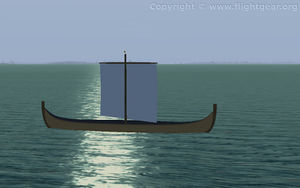Gokstad ship
 | |
| Type | Viking longship, karvi |
|---|---|
| Manufacturer | Unknown Norwegian shipwright |
| Author(s) | Anders Gidenstam |
| FDM | JSBSim |
| --aircraft= | Gokstad |
| Status | Alpha |
| FDM |
|
| Systems |
|
| Cockpit |
|
| Model |
|
| Development | |
| Website |
|
| Repository |
|
| Download |
|
| License | GPLv2+ |
|
| |
The Gokstad ship is a karvi, a small type of Viking longship. It is a 24 meter long open clinker-built hull constructed from oak and was built some time around 900 AD. Some time after, maybe about 950 - 1000 AD, it was placed as grave furniture in and below a large burial mound near the Gokstad farm in southern Norway. The ship was rediscovered in 1880 when the mound was excavated by archaeologists. The clay soil had preserved most of the hull, but the exact nature of the rigging for the single large mast, generally believed to have carried a single large square sail below a single yard, is somewhat unclear.
Handling and controls
Sail
The modelling of the rigging is in a very early state. The following controls are available for the sail:
The throttle axis (PgUp, PgDn) controls the amount of reefing. The aileron axis (←, →) controls the bracing of the yard, i.e. turns the sail.
The weather vane is a useful tool to trim the sail.
Rudder
The rudder is controlled by the standard rudder input, keypad '0' and ',' or any rudder axis connected.
Installation and Dependencies
- The Gokstad ship (GitHub, click "Download ZIP".)
This "aircraft" depends on resources from some other aircraft. Install a matching version of these too.
- Swedish Navy T21 class MTB (a.k.a. MTB_20m) (GitHub, click "Download ZIP".)
- Cessna 172P (included with FlightGear)
Known problems
- The hydrodynamics planing model may react poorly to non-smooth water surfaces (in the terrain mesh, not waves) which is not that uncommon in FlightGear's terrain.
- The hydrodynamics planing model requires a significantly increased FDM rate (the /sim/model-hz property) for good simulation results. On some systems this appears to have a considerable impact on the frame rate.